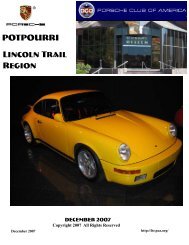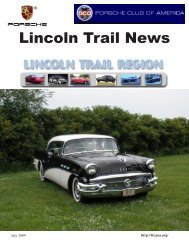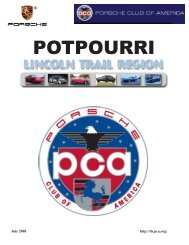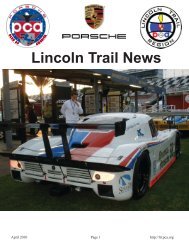Round Black Donuts, or in Other Words, Tires Part 2 Bob White ...
Round Black Donuts, or in Other Words, Tires Part 2 Bob White ...
Round Black Donuts, or in Other Words, Tires Part 2 Bob White ...
Create successful ePaper yourself
Turn your PDF publications into a flip-book with our unique Google optimized e-Paper software.
B 245/575 – 15 slick (12 K x 15)<br />
C 265/575 – 15 slick (12 K x 15)<br />
D 215/60 VR XWX (7 J x 15)<br />
E 245/575 – 15 <strong>in</strong>termediate (12 K x 15)<br />
F 340/575 – 15 slick (15 K x 15)<br />
Notice <strong>in</strong> compar<strong>in</strong>g the friction values <strong>in</strong> Figures 3 and 4 that it is imp<strong>or</strong>tant to use the<br />
same load values s<strong>in</strong>ce the weight scales are different. F<strong>or</strong> the w<strong>or</strong>st race type tires the<br />
friction values are 20% <strong>or</strong> so higher than the best street values and the best race tire<br />
values are 60% <strong>or</strong> m<strong>or</strong>e better than the street values! F<strong>or</strong> the same radius of a turn the<br />
speed <strong>in</strong>creases with the square root of the mu value which means sqrt(1.6) = 1.26 <strong>or</strong> a<br />
26% <strong>in</strong>crease <strong>in</strong> speed, i.e. a 50 mph maximum turn speed becomes 60 mph with race<br />
tires.<br />
F<strong>or</strong> straight l<strong>in</strong>e acceleration <strong>or</strong> brak<strong>in</strong>g the change is directly prop<strong>or</strong>tional to the friction<br />
value assum<strong>in</strong>g the eng<strong>in</strong>e has sufficient t<strong>or</strong>que (and c<strong>or</strong>rect gear<strong>in</strong>g) to keep the tire at<br />
its maximum friction value. This leads to another characteristic of tires, there must be<br />
some slip between the tire and the road to produce any brak<strong>in</strong>g, acceleration, <strong>or</strong> turn<strong>in</strong>g<br />
f<strong>or</strong>ce. F<strong>or</strong> brak<strong>in</strong>g and acceleration the slip is ratio of the actual rotation speed of the tire<br />
and the ideal rotational speed be<strong>in</strong>g the rotation speed if you let the tire roll down a hill<br />
by itself. We will return to what slip is f<strong>or</strong> a c<strong>or</strong>ner<strong>in</strong>g tire a bit later. Thus, a free roll<strong>in</strong>g<br />
tire has a slip of zero and a locked up tire has 100% slip. Figure no. 5 below shows how<br />
the friction varies with slip.






